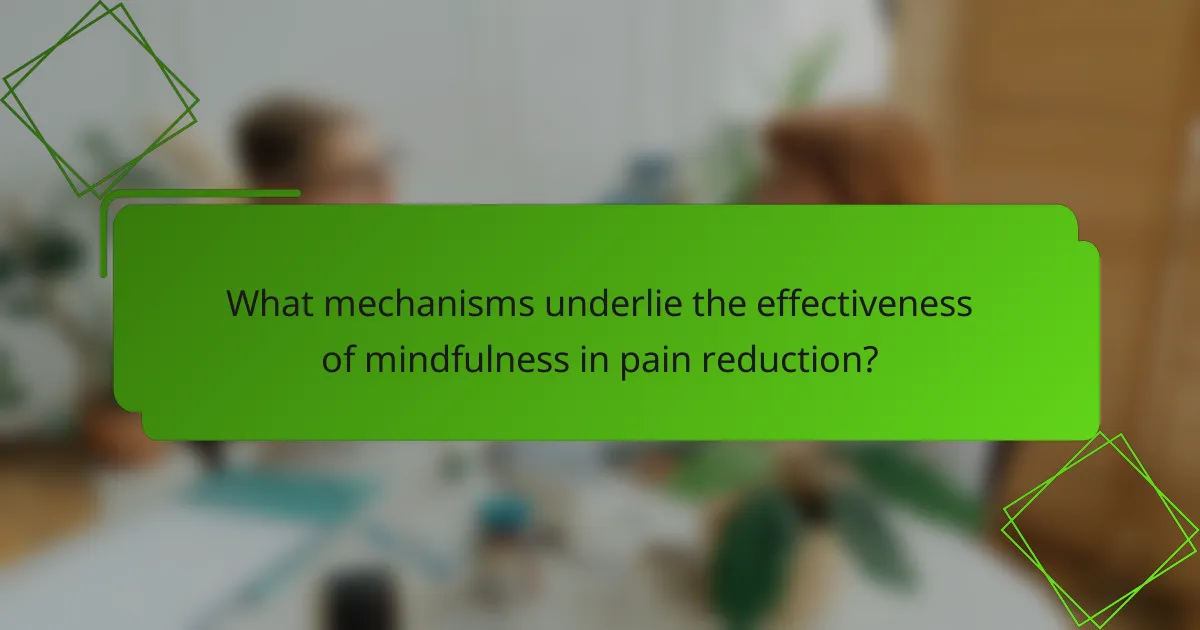
What is the Role of Mindfulness in Pain Reduction?
Mindfulness plays a significant role in pain reduction by promoting awareness and acceptance of pain. This practice helps individuals detach from the emotional response to pain. Research indicates that mindfulness can alter pain perception through neurobiological changes. A study published in the journal “Pain” found that mindfulness meditation reduces pain intensity and unpleasantness. Participants reported lower pain levels after engaging in mindfulness practices. Mindfulness also enhances coping strategies, leading to improved pain management. Furthermore, it encourages relaxation, which can decrease muscle tension associated with pain. Overall, mindfulness serves as an effective tool for alleviating pain through mental and emotional regulation.
How does mindfulness contribute to pain management?
Mindfulness contributes to pain management by enhancing awareness and acceptance of pain. It teaches individuals to observe their pain without judgment. This process can reduce the emotional response to pain. Mindfulness practices, such as meditation, have been shown to decrease pain perception. Research indicates that mindfulness can activate brain regions associated with pain regulation. A study published in the Journal of Pain found that mindfulness meditation significantly reduced chronic pain symptoms. Participants reported lower pain intensity and improved quality of life. These findings support the effectiveness of mindfulness in managing pain.
What are the key principles of mindfulness in this context?
The key principles of mindfulness in the context of pain reduction include awareness, non-judgment, and acceptance. Awareness involves paying attention to the present moment and recognizing thoughts, feelings, and bodily sensations related to pain. Non-judgment means observing these experiences without labeling them as good or bad. Acceptance allows individuals to acknowledge pain without resistance, which can reduce suffering. Research indicates that these principles can lead to decreased pain perception and improved emotional regulation. A study published in the Journal of Pain found that mindfulness practices significantly reduced chronic pain levels in participants.
How does mindfulness differ from traditional pain relief methods?
Mindfulness differs from traditional pain relief methods by focusing on mental awareness rather than physical intervention. Traditional methods often involve medication or physical therapies to alleviate pain. These approaches target the symptoms directly through pharmacological or mechanical means. In contrast, mindfulness emphasizes the acceptance of pain and the reduction of stress responses. Research shows that mindfulness can alter the perception of pain by changing how the brain processes pain signals. A study published in the journal Pain in 2016 found that mindfulness meditation significantly reduced pain perception in participants. This indicates that mindfulness can be an effective complementary strategy alongside conventional pain relief methods.
Why is mindfulness becoming a popular approach for pain reduction?
Mindfulness is becoming a popular approach for pain reduction because it helps individuals manage their pain through enhanced awareness and acceptance. This technique encourages patients to focus on their present experience rather than worrying about pain. Research shows that mindfulness can reduce the perception of pain and improve coping strategies. A study published in the Journal of Pain found that mindfulness-based interventions significantly decrease pain intensity and improve quality of life. Additionally, mindfulness practices activate brain regions associated with pain modulation, such as the prefrontal cortex. This physiological change supports the efficacy of mindfulness in pain management. The growing body of evidence and positive patient outcomes contribute to its increasing popularity as a pain reduction strategy.
What evidence supports the effectiveness of mindfulness in reducing pain?
Mindfulness has been shown to effectively reduce pain. Numerous studies support this claim. A meta-analysis published in “Pain” by Veehof et al. found that mindfulness-based interventions significantly decrease chronic pain intensity. Another study in “JAMA Internal Medicine” by Goyal et al. showed that mindfulness meditation can improve pain-related outcomes. Research indicates that mindfulness practices alter pain perception by enhancing emotional regulation and decreasing stress. Furthermore, a randomized controlled trial in “Clinical Psychology Review” by Keng et al. demonstrated that mindfulness training leads to reductions in pain and disability. These findings collectively illustrate the effectiveness of mindfulness in pain reduction.
How do patient experiences reflect the impact of mindfulness on pain?
Patient experiences indicate that mindfulness significantly reduces pain perception. Mindfulness practices help patients focus their attention away from pain. This shift in focus can lead to decreased emotional reactions to pain. Many patients report feeling more in control of their pain through mindfulness. Research shows that mindfulness can alter brain activity related to pain processing. A study published in the journal Pain by Zeidan et al. found that mindfulness meditation reduced pain sensitivity by 27%. Patients practicing mindfulness also report improved coping strategies. These experiences collectively demonstrate mindfulness’s positive impact on pain management.

What mechanisms underlie the effectiveness of mindfulness in pain reduction?
Mindfulness reduces pain through several mechanisms. It alters the perception of pain by changing how the brain processes pain signals. Research shows that mindfulness activates brain regions associated with pain regulation, such as the anterior cingulate cortex. This activation can lead to decreased emotional responses to pain. Mindfulness also encourages a non-reactive awareness of pain sensations. This approach helps individuals detach from pain, reducing its impact. Studies indicate that mindfulness practices can lower levels of stress and anxiety, which are linked to increased pain sensitivity. A meta-analysis published in the Journal of Pain found that mindfulness-based interventions significantly reduce chronic pain symptoms.
How does mindfulness affect the brain’s perception of pain?
Mindfulness alters the brain’s perception of pain by changing how pain is processed. It engages brain regions involved in pain modulation, such as the anterior cingulate cortex and insula. Research shows that mindfulness practice can reduce the subjective experience of pain. A study by Zeidan et al. (2012) demonstrated that mindfulness meditation significantly decreased pain ratings in participants. The practice also enhances emotional regulation, which can lead to lower pain sensitivity. Mindfulness promotes a non-judgmental awareness of pain, leading to reduced anxiety and fear associated with it. This shift in perspective can diminish the perceived intensity of pain. Overall, mindfulness training equips individuals with tools to manage pain more effectively.
What neurological changes occur during mindfulness practice?
Mindfulness practice induces several neurological changes in the brain. These changes include increased gray matter density in regions associated with emotional regulation, such as the prefrontal cortex. The hippocampus also shows growth, which is linked to improved memory and learning abilities. Additionally, mindfulness reduces activity in the amygdala, a region involved in stress responses. Research indicates that these alterations can enhance emotional resilience and decrease anxiety. A study by Hölzel et al. (2011) found that participants who engaged in mindfulness meditation exhibited structural changes in brain areas related to self-awareness and compassion. This evidence supports the notion that mindfulness can lead to significant neurological transformations.
How does mindfulness influence emotional responses to pain?
Mindfulness reduces emotional responses to pain by promoting a non-judgmental awareness of the present moment. This practice helps individuals observe their pain without excessive emotional reactivity. Research shows that mindfulness can decrease feelings of anxiety and fear associated with pain. Studies indicate that individuals who engage in mindfulness practices report lower pain intensity. For example, a meta-analysis published in the journal Pain in 2016 found that mindfulness-based interventions significantly reduced pain-related distress. This reduction in distress can lead to improved coping strategies and a greater sense of control over pain. Additionally, mindfulness may enhance emotional regulation, allowing for healthier responses to pain experiences.
What physiological responses are associated with mindfulness practices?
Mindfulness practices are associated with several physiological responses. These responses include reduced heart rate and lowered blood pressure. Mindfulness can also lead to decreased levels of the stress hormone cortisol. Research shows that mindfulness meditation enhances immune function. Studies indicate that mindfulness practices can increase gray matter density in brain regions related to emotional regulation. Furthermore, mindfulness has been linked to improved respiratory function. A meta-analysis published in JAMA Internal Medicine found significant reductions in pain perception among participants practicing mindfulness. These physiological changes contribute to the overall effectiveness of mindfulness in pain reduction.
How does mindfulness impact stress and its relation to pain?
Mindfulness reduces stress, which in turn can alleviate pain. Stress often exacerbates pain perceptions in individuals. By practicing mindfulness, individuals learn to manage their stress responses. This management can lead to a decrease in muscle tension and inflammation. Research shows that mindfulness-based stress reduction (MBSR) programs significantly lower stress levels. A study published in the Journal of Pain found that MBSR participants reported reduced pain intensity. Another study indicated that mindfulness can alter pain processing in the brain. These changes can lead to enhanced pain tolerance and overall well-being.
What role does breathing play in mindfulness and pain management?
Breathing plays a crucial role in mindfulness and pain management. Controlled breathing techniques enhance awareness and focus during mindfulness practices. This focus can reduce the perception of pain. Research shows that deep, slow breathing activates the parasympathetic nervous system. This activation promotes relaxation and decreases stress levels. Lower stress can lead to a reduction in pain sensitivity. Studies indicate that mindful breathing can improve emotional regulation. Improved emotional regulation can further alleviate pain experiences. Therefore, effective breathing techniques are essential in integrating mindfulness for pain management.

What are practical applications of mindfulness for pain management?
Mindfulness can be practically applied for pain management through techniques such as meditation and body awareness. These practices help individuals focus on the present moment, reducing anxiety and stress associated with pain. Mindfulness-based stress reduction (MBSR) programs have shown effectiveness in chronic pain conditions. Research indicates that MBSR can lead to significant reductions in pain intensity and emotional distress. A study published in the Journal of Pain found that participants experienced improved pain coping skills after engaging in mindfulness practices. Additionally, mindfulness can enhance self-regulation of pain perception. This approach fosters a non-judgmental awareness of pain, allowing individuals to respond to discomfort more effectively.
How can individuals incorporate mindfulness into their pain management strategies?
Individuals can incorporate mindfulness into their pain management strategies through various techniques. Practicing mindfulness meditation helps increase awareness of pain sensations without judgment. This can reduce the emotional response to pain. Engaging in deep breathing exercises can promote relaxation and decrease tension. Body scan techniques allow individuals to focus on different body parts, promoting awareness and acceptance of pain. Mindful movement practices, such as yoga or tai chi, can enhance physical flexibility and reduce discomfort. Research indicates that mindfulness-based stress reduction programs significantly alleviate chronic pain symptoms. A study published in “Pain” by Kabat-Zinn et al. found that participants experienced reduced pain intensity after mindfulness training.
What mindfulness techniques are most effective for pain relief?
Mindfulness techniques that are most effective for pain relief include mindfulness meditation, body scan, and mindful breathing. Mindfulness meditation involves focusing attention on the present moment, which can reduce the perception of pain. Research indicates that participants practicing mindfulness meditation reported lower pain levels compared to those who did not practice. The body scan technique encourages awareness of bodily sensations, promoting relaxation and reducing stress, which can alleviate pain. Mindful breathing helps regulate emotions and can decrease pain intensity by fostering a calm state. A study published in the journal “Pain” demonstrated that mindfulness-based interventions significantly reduced chronic pain in participants.
How can healthcare providers support patients in using mindfulness?
Healthcare providers can support patients in using mindfulness by incorporating mindfulness techniques into treatment plans. They can teach patients specific mindfulness practices, such as meditation and deep breathing. Providers can also encourage regular mindfulness exercises and provide resources for guided sessions. Furthermore, they can create a supportive environment that fosters mindfulness practice. Research shows that mindfulness can significantly reduce pain perception and improve overall well-being. A study published in JAMA Internal Medicine found that mindfulness meditation programs can lead to moderate improvements in pain management.
What challenges might individuals face when using mindfulness for pain reduction?
Individuals may face several challenges when using mindfulness for pain reduction. One significant challenge is the difficulty in maintaining focus during mindfulness practices. Many individuals struggle to keep their attention on the present moment, which can limit the effectiveness of mindfulness. Another challenge is the emotional discomfort that may arise during mindfulness sessions. Individuals may confront painful emotions or thoughts that they have been avoiding. Additionally, inconsistent practice can hinder progress. Regular engagement is essential for mindfulness to be effective in pain management.
Research indicates that individuals may also experience skepticism regarding mindfulness techniques. This skepticism can prevent them from fully committing to the practice. Physical discomfort can also pose a challenge. Some individuals may find it hard to sit still or concentrate due to their pain levels. Lastly, a lack of guidance or support can impede the learning process. Without proper instruction, individuals may not fully understand how to apply mindfulness effectively.
How can these challenges be overcome to enhance effectiveness?
Challenges in implementing mindfulness for pain reduction can be overcome through structured training programs. These programs should focus on teaching specific mindfulness techniques. Regular practice is essential for reinforcing these techniques. Incorporating mindfulness into existing pain management protocols can enhance effectiveness. Research shows that consistent mindfulness practice leads to better pain outcomes. A study published in the Journal of Pain found that participants who practiced mindfulness reported significantly lower pain levels. Additionally, providing support groups can help maintain motivation. Addressing individual barriers to practice is also crucial for success.
What resources are available for learning mindfulness techniques for pain reduction?
Resources for learning mindfulness techniques for pain reduction include books, online courses, and workshops. Books such as “The Mindful Way Through Pain” by Jon Kabat-Zinn provide structured guidance. Online platforms like Coursera and Udemy offer courses specifically on mindfulness for pain management. Additionally, organizations like the Mindfulness-Based Pain Relief Program provide workshops and training. Research studies, such as those published in the Journal of Pain Research, demonstrate the effectiveness of these resources in reducing pain through mindfulness practices.
The main entity of this article is mindfulness and its role in pain reduction. The article examines how mindfulness practices enhance awareness, acceptance, and emotional regulation, leading to decreased pain perception and improved coping strategies. It discusses the mechanisms underlying mindfulness, including neurological changes and physiological responses, while highlighting evidence from research studies that support its effectiveness in managing pain. Additionally, practical applications and techniques for incorporating mindfulness into pain management strategies are explored, along with challenges individuals may face and resources available for learning mindfulness techniques.